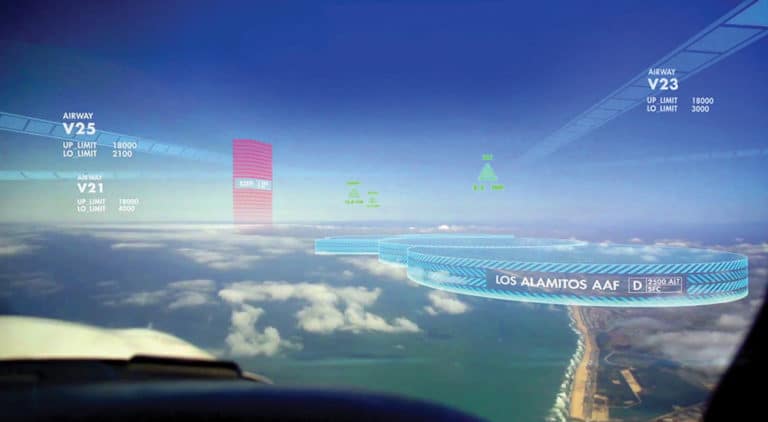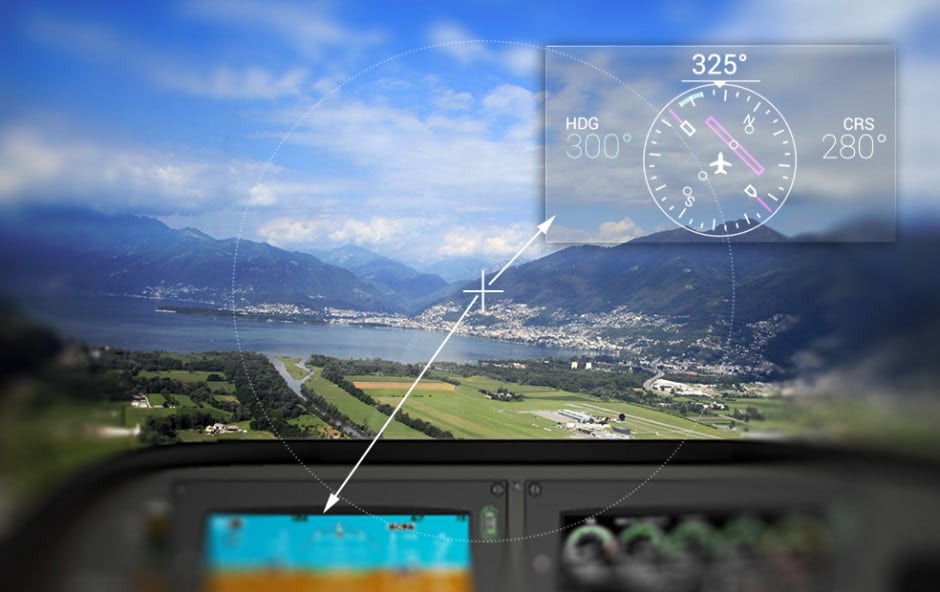
As augmented reality advances, lots of attention, innovation and investment will move from general to specialized. This includes ares we’ve examined — most of them enterprise-oriented — such as design, manufacturing and education.
One company already applying a vertical industry focus is Aero Glass. And the term “vertical” works on more than one level, as its specialty is AR in aviation. It provides technology for pilots to receive AR overlays — everything from navigational markers to illegal airspace boundaries.
This takes form in software that aggregates and processes geo-tagged aviation data for in-flight display, founder Ákos Maróy told ARtillry. And the form factor utilizes existing hardware, such as smart glasses from ODG. An overhead “marker board” is used for head tracking.
Altogether, this helps pilots navigate more effectively and conveniently than having to look down for dashboard navigation, then cognitively apply that to what they see. It turns out that graphical overlays are a natural application in Aviation, which inspired Maróy as a pilot himself.
Beyond Aviation
But Maróy seems even more excited about what’s next, and there are several potential killer apps beyond aviation. These can involve anywhere there’s a moving vehicle. Think: practical uses like search and rescue teams; or recreational ones like tourism and local commerce.
The latter includes things like city tours that show historical renderings of buildings. Or commerce apps that help users find local businesses. And there’s lots of room to gamify the experience with points and leaderboards to add additional appeal, said Maróy.
“That’s basically our vision,” he said, “an MR overlay that can be navigation and safety related, tourism related or shopping related. Eventually, we want to enable outdoor use, without having to sit in the vehicle.”

Necessary Advancement
To get to that vision, there are several advancements in the underlying technology that need to happen first — a common battle cry in the AR world. For one, better dimensional mapping and positional awareness are needed, a la SLAM.
“Generation one smart glasses are basically a tablet in a glasses form factor with a see-through display,” said Maróy. “The generational shift will come with glasses that interact with the environment you’re in, based on 3D mapping and semantics.”
Part of that advancement will be to eliminate the overhead marker-board for head tracking. This creates “vehicle intrusion” and adds friction to Aero Glass’ implementation. The goal is for inside-out tracking to replace this outside-in approach — analogous to the current state of VR.
Open for Business
Speaking of Aero Glass’ implementation, the company’s near-term business goals are to continue talking to any interests where a vehicle can benefit from AR-assisted piloting. That includes aircraft manufacturers, auto manufacturers and municipal transportation. Consumer apps will follow.
Fresh off an Auggie Award at AWE ’17, there are several directions Maróy is interested in taking the company, including seeking funding to get to the next stage. After 500 words of avoiding aviation puns: For Maróy and team it will be a matter of choosing the right flight path.
For a deeper dive on AR & VR insights, subscribe to ARtillry Intelligence Briefings, and sign up for the free ARtillry Weekly newsletter.
Disclosure: ARtillry has no financial stake in the companies mentioned in this post, nor received payment for its production. Disclosure and ethics policy can be seen here.
Header image credit: Aero Glass Corporation
